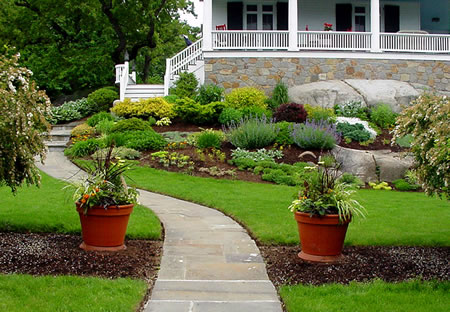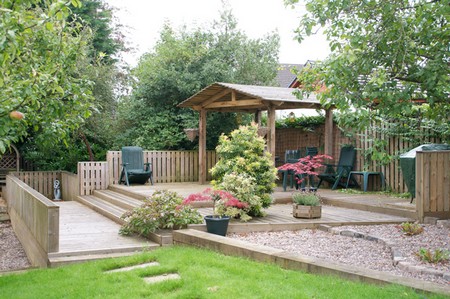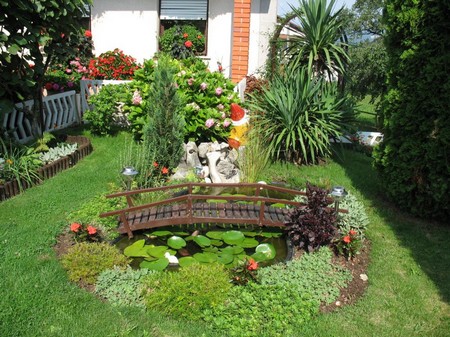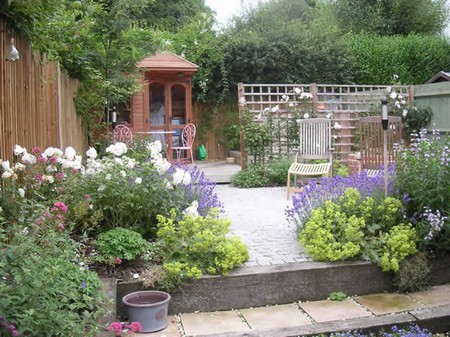The standard advice is to plan your garden on paper, starting with a sketch showing the proportions and existing features of the property, and going on to another sketch indicating where you propose putting trees, flower beds, borders, paths. I know there are personal gardens created without this planning stage (mine among them), but if you can discipline yourself to do it, it will certainly help you. For one thing, mistakes made on paper won’t cost you so much in either time or money.
Begin your garden planning by making a rough sketch with approximate proportions. If you are a meticulous kind of person, draw it to scale on graph paper, but either way don’t agonize because you think you can’t draw. This is not an art competition, it’s a gardener’s aid.
If the size of your property makes it reasonable, you can either pace it out or measure, using a long tape measure or a nylon clothesline marked at five- or ten-foot lengths with paint or some other bright marker. Indicate on your sketch the presence of trees, and whether they are deciduous or evergreen, where the sunny and shady areas are, any low-lying damp spots, and the direction of the prevailing winds.
About Those Trees
Are they where you want them? Are there too many for the sunny flower garden you want? Or do you dream of cool shade and want a woodland garden? Whether cutting down or planting more, the question of trees should be settled first. For one thing, removing trees of any size is a job for professionals, which usually involves heavy machinery and considerable disturbance to existing plantings. For another, most trees take their time growing, so the sooner you plant them, the sooner they’ll be big enough to add a look of permanence to the garden. While you don’t want to have a garden that’s a clone of all the neighbors’ gardens, it’s not a bad idea to look around you; the mature trees that you see have been proven hardy.
About The Wind
I’m a poor one to warn you about what an enemy wind can be to your garden. My New England hillside garden is subjected to strong winds from the southwest in summer and from the northwest in winter. If I had heeded the warnings when I planted my garden, there would have been few plants more than a foot high and no delphiniums at all.
There are reasonable steps that you can take to reduce the problem of wind. Once you find out from your neighbors what the prevailing winds are, summer and winter, do your best to place flower beds where they will have some protection. Years ago, all English children learned poetry by heart, recited it, even. One by John Masefield began, “It’s a warm wind, the west wind, full of birds’ cries.” Once learned, it seems, such bits and pieces are never forgotten. So there I was, in New England, waiting for a warm west wind in winter! Still waiting.
What About Shape?
If the garden area is rectangular, as” it so often is, you could take the easy way and make your garden in the shape of the lot, a rectangle within a rectangle, with flower borders around three sides and lawn in the middle. This simple layout is common in small gardens, but if yours is a large area it would result in a big lawn, perhaps more than you want to maintain. Also, the flower borders, to be in proportion, would have to be considerably wider.
If this is not interesting enough for you, then imagine the layout with curves replacing straight lines, the central lawn outlining occasional bays in the border.
Lawn Love
A word here about lawns. They have been getting poor press lately, with much said and written about noisy, gas-driven manicuring machines and dangerous weed- and insect-killing sprays, together with excessive fertilizing and wasteful watering.
Lawn love may have been carried to excess (or so it seems to a flower gardener). Go into any garden center in spring if you need evidence and you’ll find fully half the space is taken up with lawn products and paraphernalia. It does give one pause. Nevertheless, it would be a pity if, as a result, we overreacted and had to forego the pleasures of grass. A lawn can do wonderful things for a garden.
The contours of a lawn play an important role in the design, its cool green is a perfect foil for flowers of many colors, and on the social and human level, the very idea of a lawn suggests summer pleasures, safety, comfort, and ease. Not so in China, apparently. A Chinese visitor to England in the 1920s looked at the vast and velvet lawns and expressed amazement that a civilized person would want such a thing. He went further, saying he felt that grass, “while no doubt pleasing to a cow could hardly engage the intellect of a human being.” It hadn’t occurred to me that grass was supposed to engage the intellect, but there you are.
I have one strong recommendation: Don’t make a lawn that will enslave you. Forget bluegrass and other temperamental species. With a mixture of kinds of grasses (and weeds), you’ll have a lawn that can be sat on, walked on, and played on. Whatever you inherited in the way of grass can be brought up to acceptable standards and kept decent-looking without an excessive amount of care. Try to find a workable balance.
If you’re a real lawn enthusiast, skip the following account of how we made our lawn at Heath (it would pain you).
When we first cleared space for the garden we began with saws, machetes, and clippers. We progressed through several mowers, ruining each in turn, setting the blades a little lower each time we mowed, and in a year we had lawn. Does it have weeds? You bet. I don’t enjoy the plantains and dandelions, but I’m very happy with the violets and white clover. It’s tough grass and it holds up better than many fancier lawns.
Down the hill, and farther away from the flower plantings, we have pasture grass. We cut it once a year because grass doesn’t stay grass if you don’t. Give it a year, and it’s thistles, milkweed, and goldenrod; two years, and it’s juniper and hardhack; after that it’s weed trees bent on serious colonizing.
Categories
Advertisements
Recent Articles
 How to Understand Bed Sizes – A Small Guide
How to Understand Bed Sizes – A Small Guide How to Select Some Must Have Kitchen Accessories
How to Select Some Must Have Kitchen Accessories Best Way to Change a Car Tire
Best Way to Change a Car Tire Best Way to Write an Affirmation
Best Way to Write an Affirmation Best Way to Take Charge of Your Financial Life
Best Way to Take Charge of Your Financial Life Best Way to Survive a Party When You Don’t Know Anyone
Best Way to Survive a Party When You Don’t Know Anyone Best Way to Stop Self Sabotaging Yourself
Best Way to Stop Self Sabotaging Yourself Best Way to Start Journal Writing
Best Way to Start Journal Writing Best Way to Speak with a Powerful Voice
Best Way to Speak with a Powerful Voice Best Way to Simplify Your Life
Best Way to Simplify Your Life Best Way to Respond to a Put-Down
Best Way to Respond to a Put-Down Best Way to Reduce Acne Breakouts
Best Way to Reduce Acne Breakouts Best Way to Recover from Dining Disasters
Best Way to Recover from Dining Disasters Best Way to Quit Your Job Gracefully
Best Way to Quit Your Job Gracefully Best Way to Make Your Own Website
Best Way to Make Your Own Website





Leave a Reply